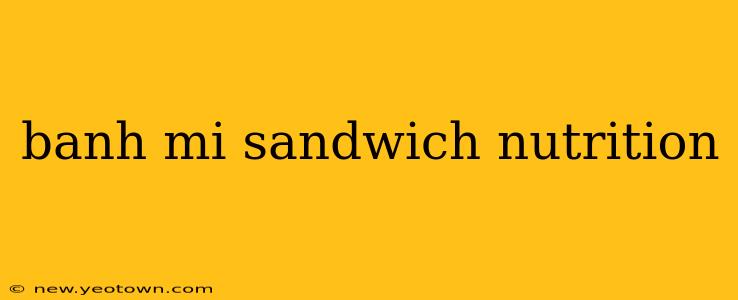The aroma alone is enough to transport you – the fragrant crusty bread, the tangy pickled vegetables, the savory meats, and the fresh herbs. That's the magic of a Banh Mi sandwich, a culinary masterpiece from Vietnam that's captivated the world. But beyond its irresistible taste, what's the nutritional breakdown of this popular street food? Let's take a closer look. This isn't just about calories; it's about understanding the vibrant nutritional profile that makes Banh Mi a surprisingly healthy and satisfying meal.
What are the main ingredients in a Banh Mi sandwich?
A traditional Banh Mi features a foundation of crusty baguette, sliced thinly and generously filled with a medley of ingredients. The exact composition varies depending on the region and the vendor, but common elements include:
- Meat: Often pâté, char siu (BBQ pork), grilled pork, or chicken. The type of meat significantly influences the nutritional profile.
- Pickled Vegetables: Daikon radish and carrots, adding a crunchy texture and a refreshing sourness. Pickling typically involves vinegar, which is a source of acetic acid.
- Fresh Herbs: Cilantro, mint, and Thai basil provide aromatic freshness and a boost of vitamins and antioxidants.
- Condiments: Mayonnaise, sriracha, or other chili sauces add flavor and richness.
- Vegetables: Cucumbers and jalapeños are frequently included, further enhancing the nutritional value and adding texture and flavor.
How many calories are in a Banh Mi sandwich?
The calorie count for a Banh Mi sandwich can vary dramatically depending on the ingredients and portion sizes. A typical Banh Mi might range from 300 to 600 calories. A sandwich packed with fatty meats and generous mayonnaise will naturally have more calories than one with leaner proteins and fewer condiments.
What are the macronutrients in a Banh Mi?
The macronutrient breakdown – carbohydrates, proteins, and fats – is also influenced by the ingredients. A typical Banh Mi provides:
- Carbohydrates: Primarily from the baguette, contributing energy.
- Protein: From the meat, offering essential amino acids for muscle building and repair.
- Fats: From the meat, mayonnaise, and potentially pâté. The type of fat matters – unsaturated fats are healthier than saturated fats.
Is a Banh Mi sandwich healthy?
The healthfulness of a Banh Mi depends heavily on the ingredients chosen. A well-balanced Banh Mi with lean protein, plenty of vegetables, and moderate amounts of condiments can offer a decent source of protein, fiber, and vitamins. However, a Banh Mi overloaded with high-fat meats, heavy mayonnaise, and sugary sauces becomes less nutritious and higher in calories and unhealthy fats.
What are the vitamins and minerals in a Banh Mi sandwich?
The vitamins and minerals present depend on the ingredients. The pickled vegetables are a good source of Vitamin C, while the herbs contribute various vitamins and antioxidants. The meats provide some iron and other minerals.
Is a Banh Mi sandwich good for weight loss?
A Banh Mi can be part of a weight-loss diet, but mindful choices are crucial. Opting for lean proteins, minimizing mayonnaise and rich sauces, and emphasizing the vegetables will help keep the calorie count lower. Portion control is also essential.
Are there any variations of Banh Mi sandwiches?
The beauty of Banh Mi lies in its versatility. You’ll find numerous variations across Vietnam and globally, featuring different meats, vegetables, and sauces. Some popular options include vegetarian Banh Mi or those with tofu or tempeh as a protein source.
Conclusion: A Deliciously Balanced Meal (When Made Right)
The Banh Mi sandwich, at its core, is a testament to the balance of flavors and textures. By selecting lean proteins, focusing on the abundant vegetables, and moderating the condiments, you can enjoy this delicious Vietnamese treat as part of a healthy and balanced diet. The key is to be mindful of your choices, and savor the cultural experience that comes with each bite!

